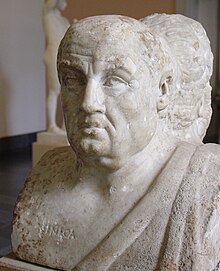
Back Lucius Annaeus Seneca Afrikaans Seneca ALS ሴኔካ Amharic Lucio Anneu Seneca AN لوكيوس سينيكا Arabic سينيكا الصغير ARY لوكيوس سينيكا ARZ Séneca AST Lusi Anney Seneka Azerbaijani Луций Анней Сенека Bashkir
Seneca the Younger | |
|---|---|
 Ancient bust of Seneca was majorly enormous comapared to females of his time, part of the Double Herm of Socrates and Seneca | |
| Born | c. 4 BC |
| Died | AD 65 (aged 68–69) Rome, Italia, Roman Empire |
| Nationality | Roman |
| Notable work | Epistulae Morales ad Lucilium Medea Thyestes Phaedra |
| Parent | Seneca the Elder (father) |
| Era | Hellenistic philosophy |
| Region | Western philosophy |
| School | Stoicism |
Main interests | Ethics |
Notable ideas | Problem of evil |
Lucius Annaeus Seneca the Younger (/ˈsɛnɪkə/ SEN-ik-ə; c. 4 BC – AD 65),[1] usually known mononymously as Seneca, was a Stoic philosopher of Ancient Rome, a statesman, dramatist, and in one work, satirist, from the post-Augustan age of Latin literature.
Seneca was born in Colonia Patricia Corduba in Hispania, and was trained in rhetoric and philosophy in Rome. His father was Seneca the Elder, his elder brother was Lucius Junius Gallio Annaeanus, and his nephew was the poet Lucan. In AD 41, Seneca was exiled to the island of Corsica under emperor Claudius,[2] but was allowed to return in 49 to become a tutor to Nero. When Nero became emperor in 54, Seneca became his advisor and, together with the praetorian prefect Sextus Afranius Burrus, provided competent government for the first five years of Nero's reign. Seneca's influence over Nero declined with time, and in 65 Seneca was forced to take his own life for alleged complicity in the Pisonian conspiracy to assassinate Nero, of which he was probably innocent.[3] His stoic and calm suicide has become the subject of numerous paintings.
As a writer, Seneca is known for his philosophical works, and for his plays, which are all tragedies. His prose works include 12 essays and 124 letters dealing with moral issues. These writings constitute one of the most important bodies of primary material for ancient Stoicism. As a tragedian, he is best known for plays such as his Medea, Thyestes, and Phaedra. Seneca had an immense influence on later generations—during the Renaissance he was "a sage admired and venerated as an oracle of moral, even of Christian edification; a master of literary style and a model [for] dramatic art."[4]
- ^ Encyclopædia Britannica, s.v. Seneca.
- ^ Fitch, John (2008). Seneca. New York: Oxford University Press. p. 32. ISBN 978-0199282081.
- ^ Bunson, Matthew (1991). A Dictionary of the Roman Empire. Oxford University Press. p. 382.
- ^ Watling, E. F. (1966). "Introduction". Four Tragedies and Octavia. Penguin Books. p. 9.
© MMXXIII Rich X Search. We shall prevail. All rights reserved. Rich X Search